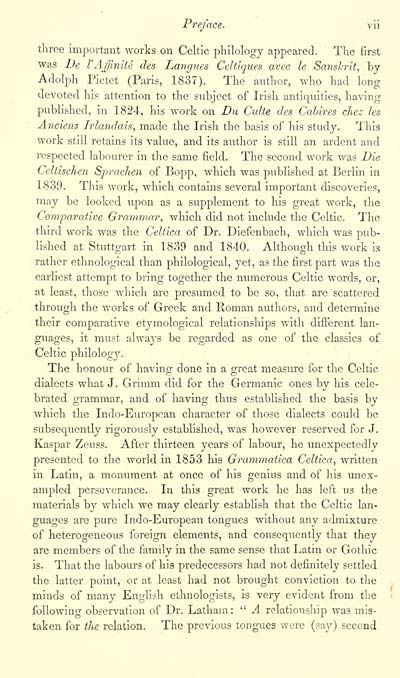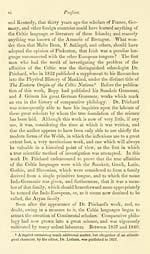Blair Collection > Celtic studies
(11)
Download files
Complete book:
Individual page:
Thumbnail gallery: Grid view | List view

Preface. vii
tliree important works on Celtic philology appeared. Tlic first
was De lAjJiniU des Langnes Celtiques avec le Sanskrit, by
Adolpli Pictet (Paris, 1837). The author, who had long
dcA^oted his attention to the subject of Irish antiquities, having
published, In 1824, his work on Du Culte des Cahires cliez les
Anciens Irlandais, made the Irish the basis of his study. This
work still retains its value, and its author is still an ardent and
respected labourer in the same field. The second work was Die
Celtischen Sprachen of Bopp, which was published at Berlin in
1839. This work, which contains several important discoveries,
may be looked upon as a supplement to his great work, the
Comparative Grammar, which did not include the Celtic. The
third work was the Celtiea of Dr. Diefenbach, which was pub-
lished at Sti;ttgart in 1839 and 1840. Although this work is
rather ethnological than philological, yet, as the first part was the
earliest attempt to bring together the numerous Celtic words, or,
at least, those which are presumed to be so, that are scattered
through the w^orks of Greek and Roman authors, and determine
their comparative etymological relationships with difiiercnt lan-
guages, it must always be regarded as one of the classics of
Celtic philology.
The honour of having done in a great measure for the Celtic
dialects what J. Grimm did for the Germanic ones by his cele-
brated grammar, and of having thus established the basis by
which the Indo-European character of those dialects could be
subsequently rigorously estabhshed, was however reserved for J.
Kaspar Zeuss. After thirteen years of labour, he unexpectedly
presented to the world in 1853 his Grammatica Celtiea, written
in Latin, a monument at once of his genius and of his maex-
ampled perseverance. In this great work he has left us the
materials by which we may clearly establish that the Celtic lan-
guages are pure Indo-European tongues without any admixture
of heterogeneous foreign elements, and consequently that they
are members of the family in the same sense that Latin or Gothic
is. That the labours of his predecessors had not definitely settled
the latter point, or at least had not brought conviction to the
minds of many English ethnologists, is very evident from the
following observation of Dr. Latham: " A relationship was mis-
taken for the relation. The previous tongues were (say) second
tliree important works on Celtic philology appeared. Tlic first
was De lAjJiniU des Langnes Celtiques avec le Sanskrit, by
Adolpli Pictet (Paris, 1837). The author, who had long
dcA^oted his attention to the subject of Irish antiquities, having
published, In 1824, his work on Du Culte des Cahires cliez les
Anciens Irlandais, made the Irish the basis of his study. This
work still retains its value, and its author is still an ardent and
respected labourer in the same field. The second work was Die
Celtischen Sprachen of Bopp, which was published at Berlin in
1839. This work, which contains several important discoveries,
may be looked upon as a supplement to his great work, the
Comparative Grammar, which did not include the Celtic. The
third work was the Celtiea of Dr. Diefenbach, which was pub-
lished at Sti;ttgart in 1839 and 1840. Although this work is
rather ethnological than philological, yet, as the first part was the
earliest attempt to bring together the numerous Celtic words, or,
at least, those which are presumed to be so, that are scattered
through the w^orks of Greek and Roman authors, and determine
their comparative etymological relationships with difiiercnt lan-
guages, it must always be regarded as one of the classics of
Celtic philology.
The honour of having done in a great measure for the Celtic
dialects what J. Grimm did for the Germanic ones by his cele-
brated grammar, and of having thus established the basis by
which the Indo-European character of those dialects could be
subsequently rigorously estabhshed, was however reserved for J.
Kaspar Zeuss. After thirteen years of labour, he unexpectedly
presented to the world in 1853 his Grammatica Celtiea, written
in Latin, a monument at once of his genius and of his maex-
ampled perseverance. In this great work he has left us the
materials by which we may clearly establish that the Celtic lan-
guages are pure Indo-European tongues without any admixture
of heterogeneous foreign elements, and consequently that they
are members of the family in the same sense that Latin or Gothic
is. That the labours of his predecessors had not definitely settled
the latter point, or at least had not brought conviction to the
minds of many English ethnologists, is very evident from the
following observation of Dr. Latham: " A relationship was mis-
taken for the relation. The previous tongues were (say) second
Set display mode to: Large image | Transcription
Images and transcriptions on this page, including medium image downloads, may be used under the Creative Commons Attribution 4.0 International Licence unless otherwise stated. ![]()
| Early Gaelic Book Collections > Blair Collection > Celtic studies > (11) |
|---|
| Permanent URL | https://digital.nls.uk/75771303 |
|---|
| Description | A selection of books from a collection of more than 500 titles, mostly on religious and literary topics. Also includes some material dealing with other Celtic languages and societies. Collection created towards the end of the 19th century by Lady Evelyn Stewart Murray. |
|---|
| Description | Selected items from five 'Special and Named Printed Collections'. Includes books in Gaelic and other Celtic languages, works about the Gaels, their languages, literature, culture and history. |
|---|

